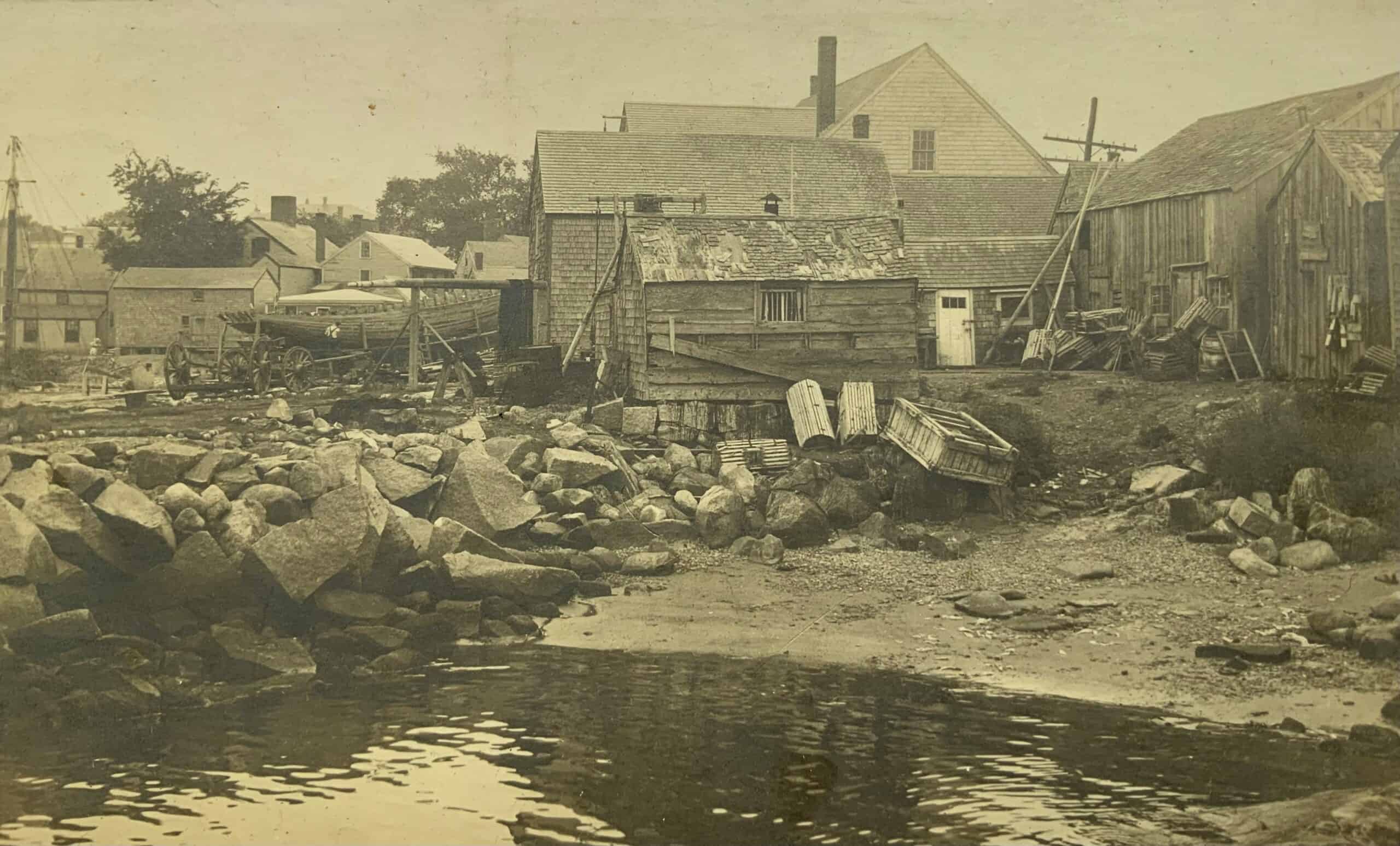Today Scituate Harbor is a vibrant part of the town with a broad range of shops, restaurants, waterfront activities, entertainment venues, artists, along with residential condominiums and apartments. And, although there are remnants of its past maritime activities, including a small fishing fleet, charter and recreational boats, and a Coast Guard Station, much of the recent development in the Harbor has continued to disguise the bustling maritime harbor of 200 years ago, which for a time, made Scituate the most prosperous town in Plymouth County.
This prosperity was based on the industries of shipbuilding and fishing. Two hundred years ago, residents of Scituate would go to the docks in the harbor when they saw the tall spars and rigging of a coastal schooner entering the Harbor loaded with goods from Boston, which may have included goods from exotic lands, such as China or India.¹ Rev. Samuel Deane, in his 1831 history of the town, said that in 1830 there were two coastal trading ships (known as packet boats) going between Scituate Harbor and Boston daily.² These ships would have joined as many as 60 ships anchored in the Harbor, many of them built at shipyards in the Harbor. Some of the boats built in the Harbor supported the town’s fisheries, including 35 fitted out for mackerel fishing in 1830. Fisheries had been providing income for Scituate residents for years, including 1828, when over 15,000 barrels of mackerel were taken by Scituate vessels.³ Unfortunately, little evidence of the old shipyards exists in the Harbor today.
In 1889, L. Vernon Briggs’ book, History of Shipbuilding on North River, was published. In the book Briggs identified over a thousand ships that had been built at shipyards on the North River and at Scituate Harbor from 1640 to 1872 and the genealogies of the shipbuilders and their families. Initially this book was read by only a few people because of its cost, with local libraries allowing copies to be read only at the library but not borrowed. However, in 1970 the Norwell Historical Society reprinted the book, which significantly lowered its cost making it more accessible to the general public.
In 1918, in part due to the publication of Briggs’ history, a group of Norwell residents formed the North River Historical Association for the purpose of locating the sites of the former North River shipyards and placing shipyard plaques at the sites that could be seen from the North River. A century later local residents organized the North River Shipyard Restoration Project, to restore the ten initial signs, many of which had deteriorated, and hopefully place plaques that identified other former shipyards on the river. Ten restored plaques are now visible from the North River.
As a result of the broader availability of Briggs’ book, the increase in the population and the number of boats on the North River, and efforts by groups such as the North and South Rivers Watershed Association to restore and protect the river, as well as promote recreational use of it, there has been an increased interest in the history of shipbuilding on the river and its importance to the development of towns on it, especially Scituate, within which most of the shipyards were once located, since the towns of Hanover and Norwell were initially part of Scituate. However, lost in this revival of interest in shipbuilding on the North River is the history of shipbuilding in Scituate Harbor. This article is an attempt to shine some light on that history.
Early settlers in Scituate were very aware of the forests of white oak, cedar, hard pine and black walnut, which were close to the water’s edge and provided an abundant supply of high quality lumber. Well into the 1700s an average large tree cut down in Scituate could yield 2800 board feet of lumber, 2000 shingles, and four cords of firewood.⁴ Early settlers arrived in Scituate at a protected harbor between Cape Cod and Boston and settled near or at the harbor. This natural harbor and the abundance of wood from the forests created a favorable environment for shipbuilding. As depicted by Duncan Bates Todd in her book, The Fourteenth Lot, during its early history the Harbor was a full of activities “to accommodate the shipbuilding, fishing and packing, trading and other activities, there were two general stores, a counting house or fish house, a cooper’s shop, a nailer’s shop, and a sail loft occupying the Stage House Beach and Creek area.”⁵
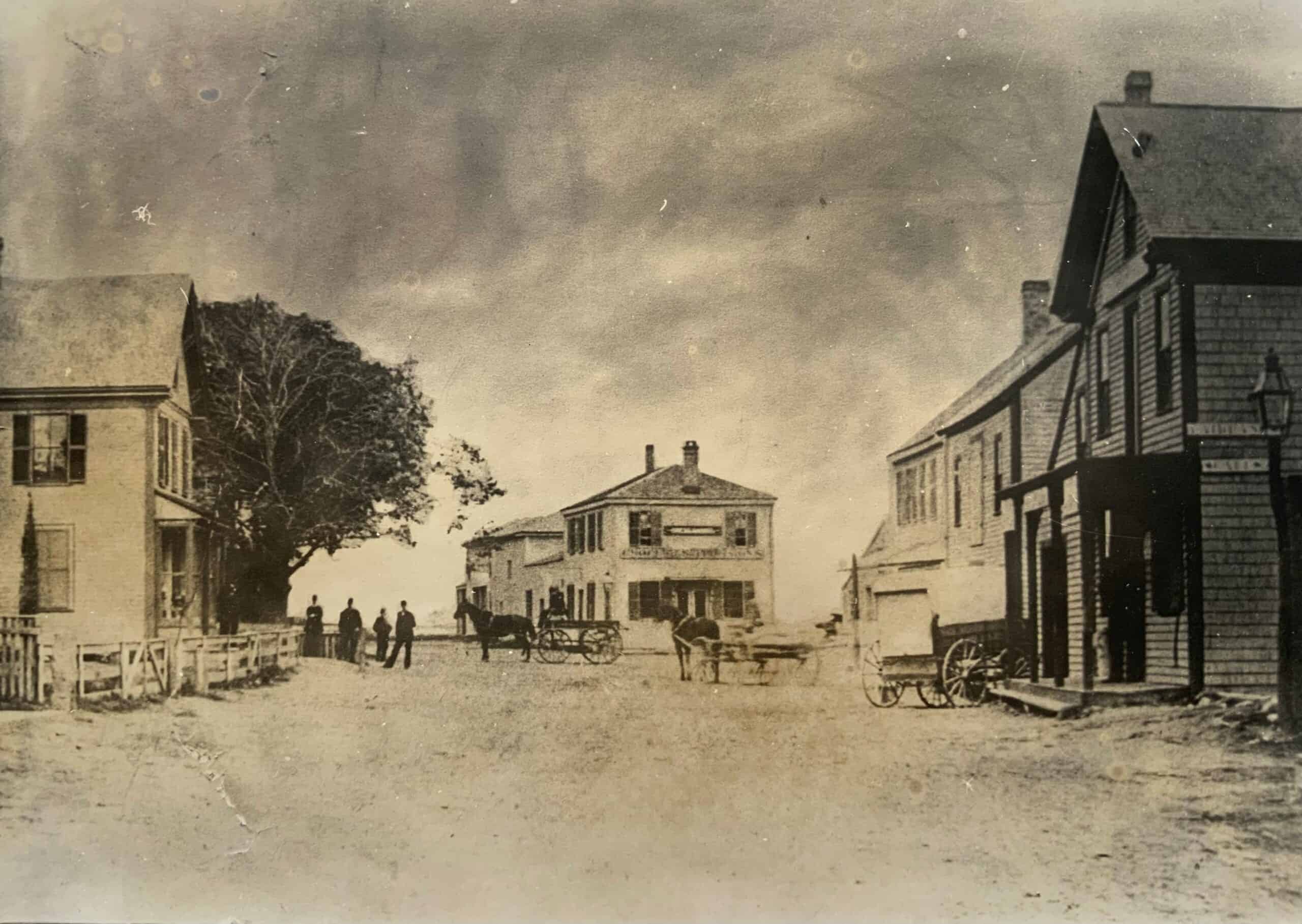
While Scituate Harbor provided a favorable environment for shipbuilding it had one major flaw that would limit the construction of large ships. Unfortunately, there was a sandbar at the entrance to the harbor that had a maximum high tide depth of ten feet, with a depth of two and one-half feet at mean low water. This limited access to the sea for large vessels with drafts over ten feet. The entrance to the harbor was also obstructed by many sunken boulders and there was little protection from major ocean storms.
There would be projects over the years that would attempt to correct these deficiencies, including several proposals to build a canal connecting Scituate Harbor and the North River. One of these was a petition by Jesse Dunbar for a dam across Mill Creek and Main Creek at the Harbor. It was approved after he agreed to allow the construction of a potential canal to the North River, “provided there would be sufficient passage for vessels and boats to pass in deeper water at no charge.” Eventually the Federal Government instituted a project between 1829 and 1859 that built an 835 feet stone bulkhead that protected the beach between Cedar Point and the mainland. ⁶
Although the age of building major ships in Scituate Harbor ended in the 1860s, efforts to improve Scituate Harbor continued in the late 19th and early 20th centuries, thanks to the tireless efforts of Scituate resident, George Lunt, who was an author, lawyer, and advocate for making Scituate a harbor of refuge. Although Scituate did not become a harbor of refuge, between 1880 and 1903 the US Army Corps of Engineers built two jetties, one on each side of the harbor entrance and dredged areas of the harbor to aid navigation at a cost of $103,500, which is the equivalent of over $3 million today. ⁷ This in essence created the harbor we know today.
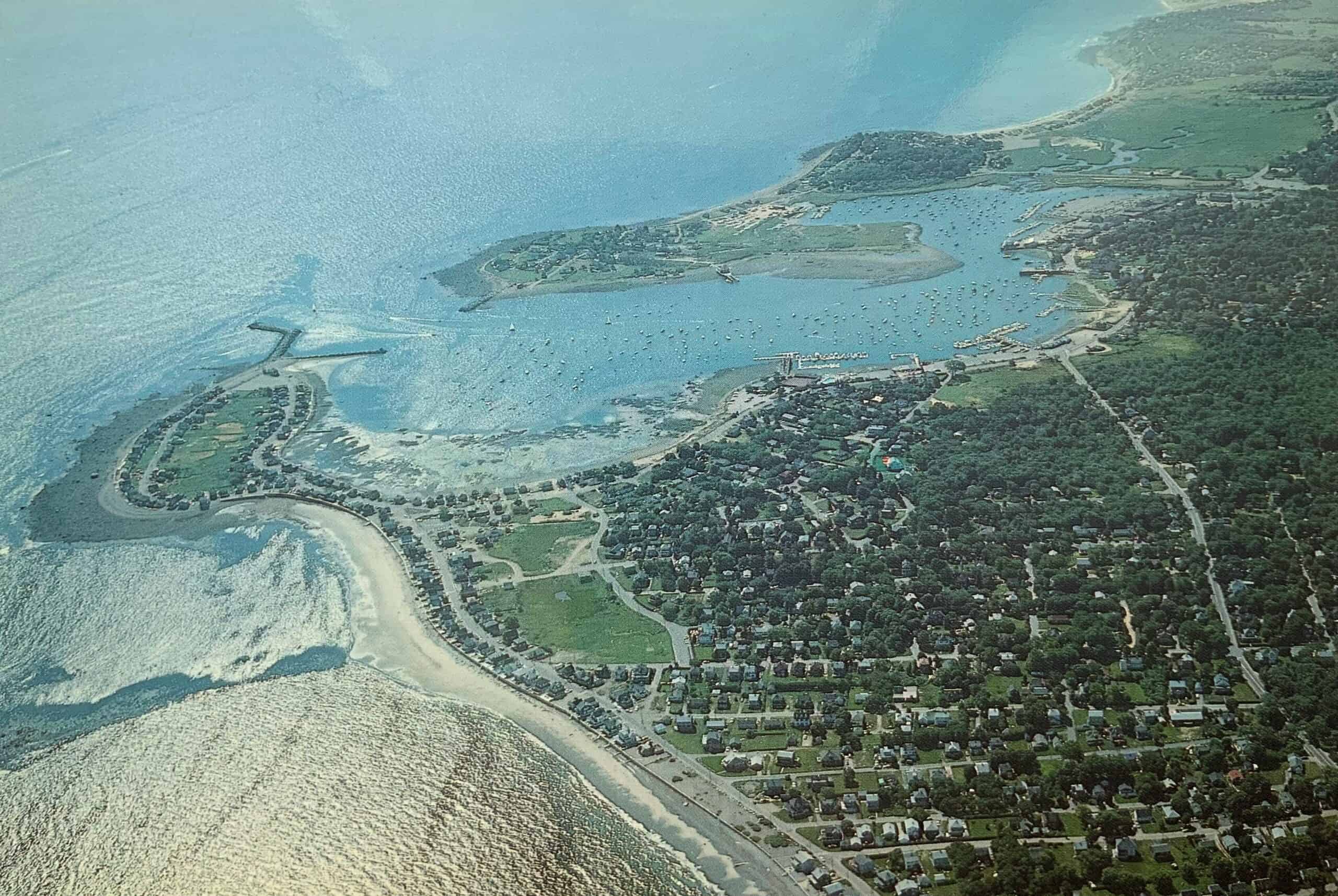
Determining the number of ships built in Scituate Harbor between 1640 and 1864 is difficult. It starts with the uncertainty of when the first ship was built in Scituate Harbor. Was it 1640, 1646, 1650, or 1673? These are all dates cited by various authors of when William James built the first vessel in the harbor. It appears that James came to Scituate in 1650 but did not live in the harbor until 1673. Some local authors used these dates to make the claim that shipbuilding in Scituate Harbor preceded shipbuilding on the North River by almost 20 years. They base this claim on the belief that the first ship launched on the North River was in 1690. However, according to Briggs, a shipwright, Thomas Nichols, was building ships at Hobart’s Landing on the North River near Little’s Bridge in 1645, This site later became the Briggs shipyard, where at least two ships were built in 1678. It is also likely that there were numerous small boats built by early settlers on the North River and at Scituate Harbor before 1645.
Another problem with determining the number of ships built in Scituate Harbor is that the records are incomplete because the records of registered vessels from 1706 to 1776 were confiscated by the British during the American Revolution. There is no evidence that I am aware of that these confiscated records have been returned by the British. I suspect they were either destroyed or lost.
Another issue is that there were 89 ships built in Scituate that can’t be identified as being built in the Harbor, although most probably were. Briggs categorizes these ships, “Scituate Misc.” So how many ships were built in Scituate Harbor? If one takes Briggs’ list of ships built in Scituate Harbor and combines it with the Scituate Misc. ships, it amounts to a total of 190, which included 92 schooners, 28 brigantines, 27 Sloops, 16 ships, 15 barks, 8 brigs and 4 ketches: a ketch or katch being a small boat rigged something like a sloop with one or two masts. As noted earlier, because of the sandbar at the harbor entrance many of these ships would have been smaller ships, sloops and schooners, used for the fishing trade or ships built for merchants engaged in coastal trade. Most of these ships would have been built at one of the major shipyards in the Harbor, which operated over two centuries, during which they changed ownership and with some builders constructing ships at more than one yard.
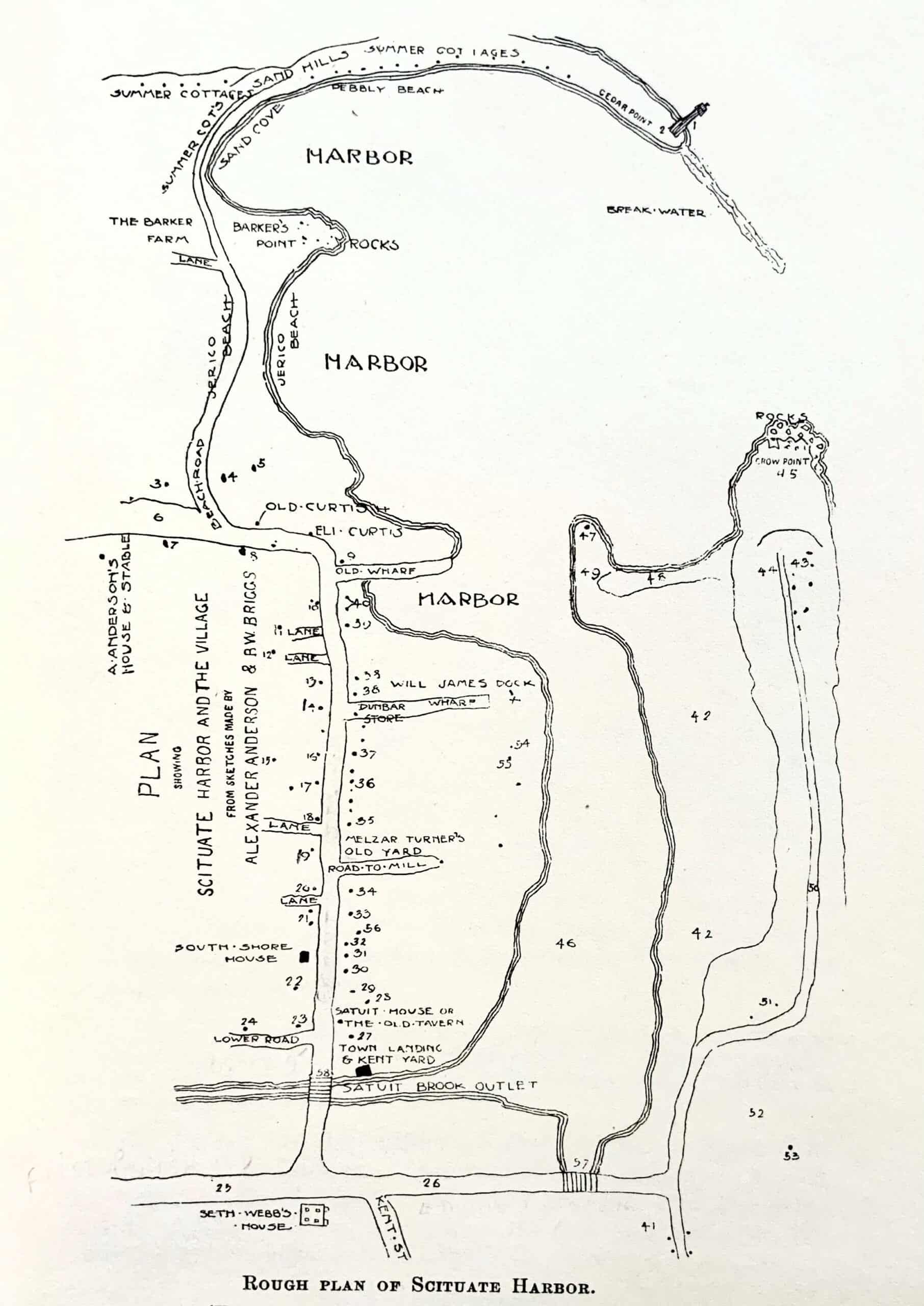
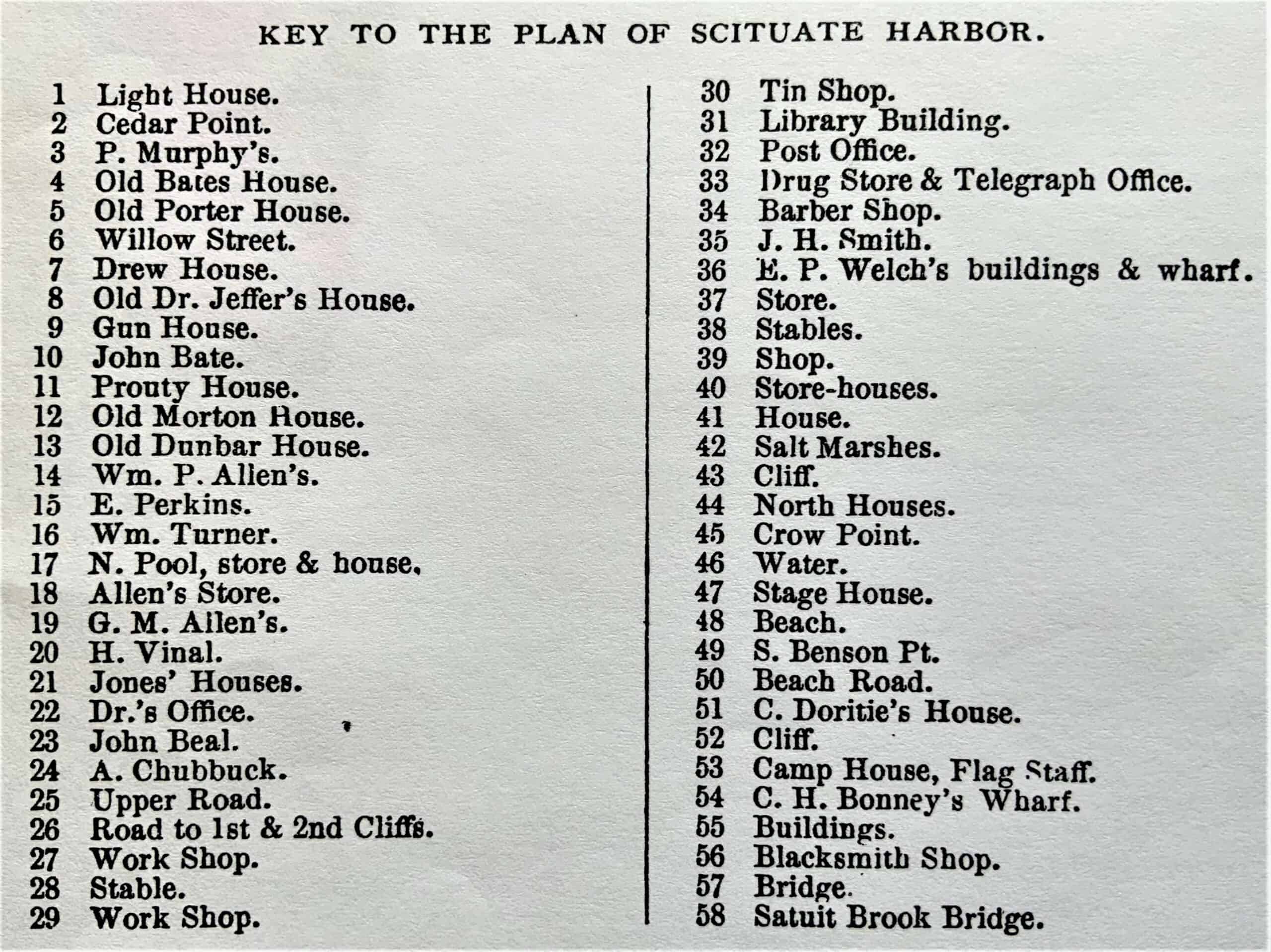
If one goes south on Front Street we come across the site of the first shipyard, known as Will James’ Dock. It was located at the head of the Harbor across from what used to be the mansion of Jesse Dunbar, Esq., located on what is now the parking lot for TK O’Malley’s. By 1797, Dunbar owned most the 30 lots on the Harbor, which were originally the property of the Conihasset Partners from 1646 to 1701.⁸ He was also the owner of the largest fishing fleet in the Harbor, with most of the boats involved in both coastal trade and fisheries enterprise. In 1802 Jesse Dunbar rebuilt Will James’s dock, which became known as Dunbar’s wharf. After 1802 many boats likely embarked from this newly constructed wharf, including 24 boats launched between 1847 and 1864.⁹
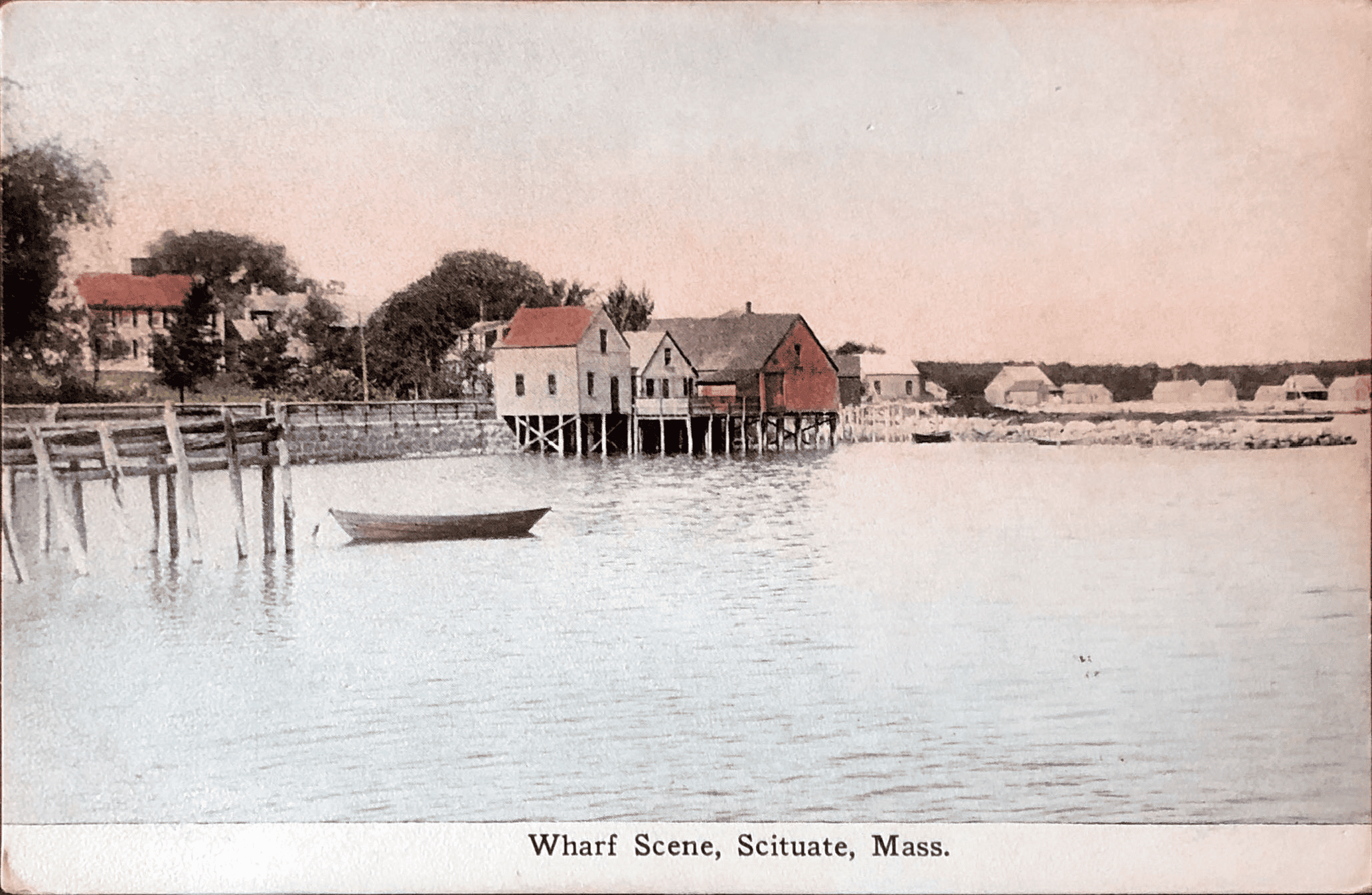
There is consensus that William James was the first to establish a shipyard in the Harbor, but, as has been noted earlier, when this happened is unclear. Deane states in his 1831 history of Scituate that Will James began building ships in the Harbor in 1646. Others, including Briggs, have James coming to Scituate from Marshfield in 1650 and not settling at the Harbor until 1673. There is no proof that James built any ships before settling at the Harbor. In fact, although between 1678 and 1706 more ships were built in Scituate than any other town in New England except Boston, many of the specific shipyards they were built at are unknown.
A typical ship registration entry, such as this one from 1698, would read: “That the slp .Unity, of Boston … being a square sterned vessel of the burthen of about Forty Tons, was built in Scituate in New England around 1697…” or like the 1700 registration entry, that the Katch, Sarah’s Adventure, … being a round sterned Vessel of 40 tons, was built at Scituate in the year 1699 … “.¹º There were other shipbuilders in Scituate at this time, such as John Kent, who probably built here in 1700 and had a descendant who built many ships in Scituate Harbor a century later. All that can be said with certainty is that there were many ships built in Scituate in the late 17th and early 18th centuries, many of them were built at the Harbor and some at William James’ shipyard. What there is agreement on is that Will James’ dock was an unusual one, dug with a gradual slope so that he could launch his boats directly into the water instead of from a raised dock. It is believed that Job Otis succeeded William James at his yard in 1700. There is positive proof of only one vessel he built, the 30 ton Ketch Little Otis.
Continuing south on Front Street the next shipyard was the Melzer Turner Shipyard at which ships were built from 1837 to 1864. It was located on land now occupied by shops and the Scituate Harbor Condominiums. Melzer Turner had previously built ships at the well-known Brick Kiln Shipyard on the North River in Pembroke and came to Scituate in 1836, although he continued to work at the Brick Kilns Yard with Luther Briggs. In 1845, Luther Briggs helped Melzer build a vessel at his Scituate Harbor yard and together they built ships at both yards until 1848 when they built only at Scituate Harbor at what was known as the Briggs-Turner Yard. In 1847, Melzer Turner created an additional shipbuilding firm when he joined with Scituate shipbuilders Edwin Otis and Andrew Cole to form the firm Turner, Otis, and Cole, which was located at the back of the store at Dunbar’s Wharf at the head of James’ Dock. Many of the ships these yards built were much larger than the earlier ships built at the Harbor. These included the 198 ton bark, LAWRENCE, also registered as the Laurence, built in 1842 of oak and copper fastened, the 497 ton brig the EMPIRE, in 1848, and the 475 ton bark ALMATIA in 1856.¹¹ It appears that the work done to improve the Harbor by the government made building larger ships more practical. However, at the same time merchants were requesting even larger ships, which contributed to the demise of shipyards in both Scituate Harbor and the North River, since it would be next to impossible to get bigger ships out of the river or harbor.
It should be noted that there were several notable shipbuilders in the Harbor who built at different yards, such as the Meltzer Turner or James’ Dock, or at docks which cannot be determined. In 1848-49 a company of several ship carpenters built a vessel, the 76 ton schooner SARAH BROOKS, in the Harbor on their own. There were 13 owners, one of which, Israel Nichols, became the commander of the vessel. Nichols had it seems been recently discharged from the almshouse, where he had been confined for over five years in an iron cage because he was considered insane. He successfully commanded the ship on fishing voyages in the summer and coastal trading to the Carolinas in the winter. Other notable independent shipbuilders include Asa Rogers, who built in the Harbor beginning in 1803; Elisha Merritt, who built ships both in the Harbor and the North River and was a descendent of Henry Merritt one of the first settlers of Scituate; and William Vinal, who built ships in the Harbor as early as 1786 and had a large interest in the fisheries business and was a descendant of Ann Vinal who resided in Scituate in 1636.¹²
Continuing south down Front Street we come to the last of the three major Harbor shipyards, the Kent Shipyard, which operated from 1798 to 1864. The yard was started by Samuel Kent and was located at the South Landing on the creek near the mouth of the Satuit Brook, which was much deeper and clearer than it is today. The Watson Family Hardware and Satuit Bowling alley are located there today. Between 1798 and 1818 Samuel Kent built more vessels than anyone else in the Harbor. Between 1798 and 1807 he built 14 ships at his yard including the 70 ton schooner, the ELIZA, which was one of the many ships owned by Jesse Dunbar and the 94 ton schooner, the NANCY, which was used as a North River packet boat, commanded by one the more famous packet boat commanders, Capt. Asa Sherman. The last ship he built was the 114 ton brig, the ORACLE, after which he moved to South Boston where he repaired old vessels.¹³
Others who built ships at the Kent Yard included Capt. Noah Brooks who served as an apprentice to his brother-in-law Samuel Kent and who built the 150 ton brig, the TROPIC, in 1804 when he was 22 years old. He died in 1852 in Dorchester, MA after being thrown from a sleigh. In 1834, brothers Sylvester and Barnabus Briggs built three schooners at the Kent Yard before moving the operation to the Will James’ Dock. In 1859, the last vessel built by Sylvester and Barnabus Briggs was the largest built at the Harbor, the 650 ton bark EVELINE, who on her maiden voyage arrived at her destination two days ahead of schedule.
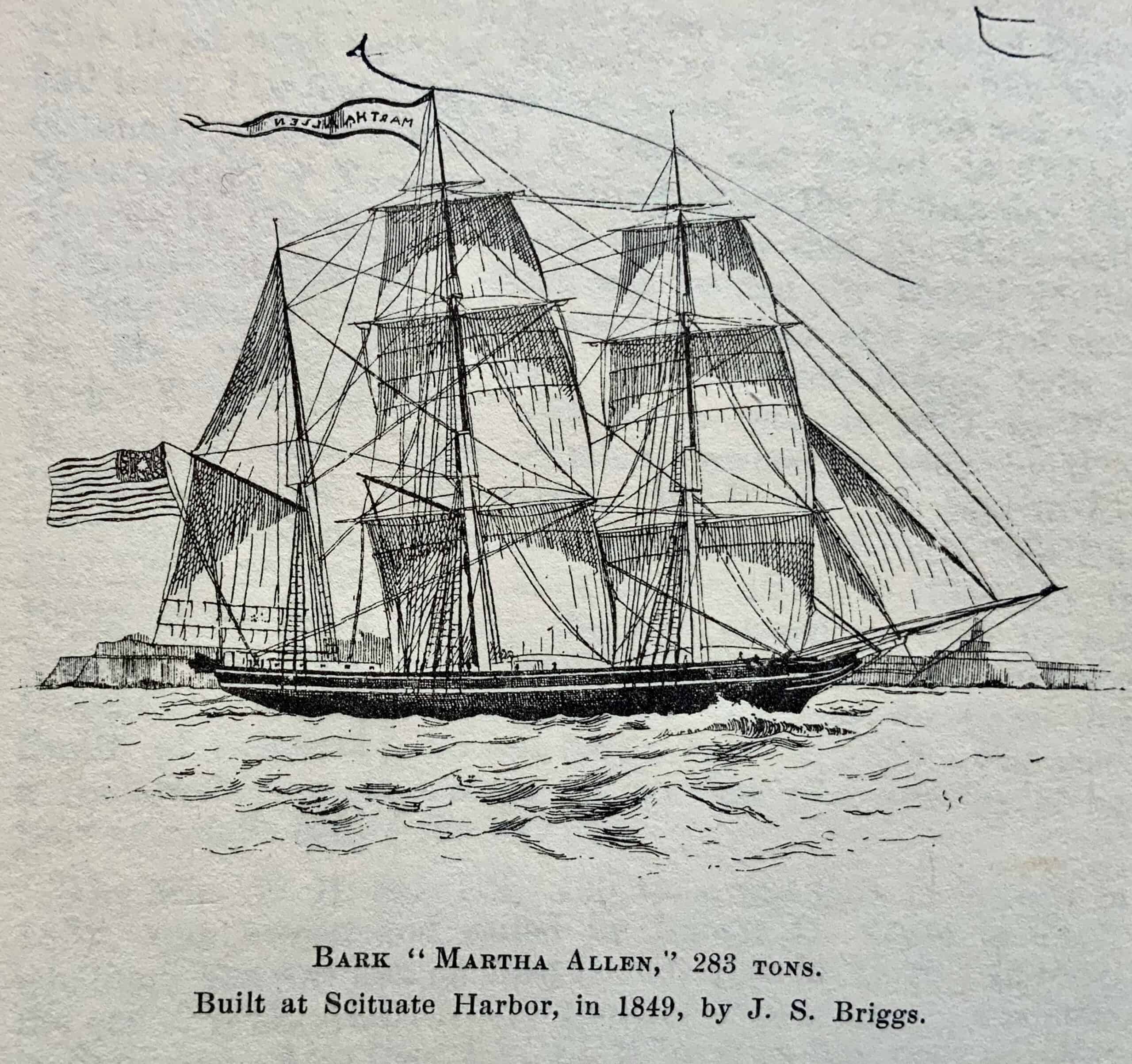
One of the more interesting stories of ships built in the Harbor involved the bark, J.A. Jesuroon, built by Sylvester Briggs in 1845 and involved the son of shipbuilder William Vinal; Capt. Henry Vinal. The following account is from L. Vernon Briggs.
“She was built for J.A. Jesuroon, a foreigner, who owned one third of her. Capt. Vinal and others were interested in her. While she was lying at her wharf in Boston, loading for a foreign voyage, Capt. Vinal was asked how much he would take for her. “$10,000,” he replied. She was sold and fitted out for California in 1849. Capt. Vinal, when at Curacoa (an island In the south Caribbean) during one of his voyages, got the merchants and others quite interested telling them about our rabbits, describing of course as having long ears, short tails, and “how soft they were” and “how high they would jump,” and they asked him to bring some down at any price. When he returned home he set the boys to work with their box-traps and got a number which he took down to Curacoa. It was really a financial success as the merchants paid him $2.00 for the rabbits, $2.00 for catching them, and $2.00 for taking them down, making $6.00 apiece.”¹⁴
In 1889, at the time Briggs wrote his book on shipbuilding in the Harbor and the North River, a few of the old shipbuilders and captains were still alive, including Barnabus Briggs, who provided him with stories and valuable information about the ships and the people who built and sailed them at the Harbor.
In 1864, the last recorded large ship built in the Harbor was the 116 ton schooner METEOR. Fittingly, we do not know at which specific shipyard it was built. Although the large-ship builders were gone from the Harbor, they were succeeded by builders of small boats and yachts well into the 20th century.
One of these was George Lawley, who left the famous Donald MacKay’s clipper ship yard in East Boston to build yachts in Scituate from 1866 to 1874, earning a worldwide reputation as a yacht builder. In 1874, he moved his yard to South Boston’s Pleasant Bay.¹⁵
William Bates, more commonly referred to as “Capt. Bill” Bates, was born in Scituate and grew up in a house on Front Street across from the harbor wharfs. As a young man he spent ten years in the shipyards of East Boston where he became a skilled caulker. He returned to Scituate with his wife and daughter in 1856. Along with his brother Caleb he owned a packet boat and a schooner used for cod fishing and soon established his boat shop at the South Landing near the former Kent ShipYard.
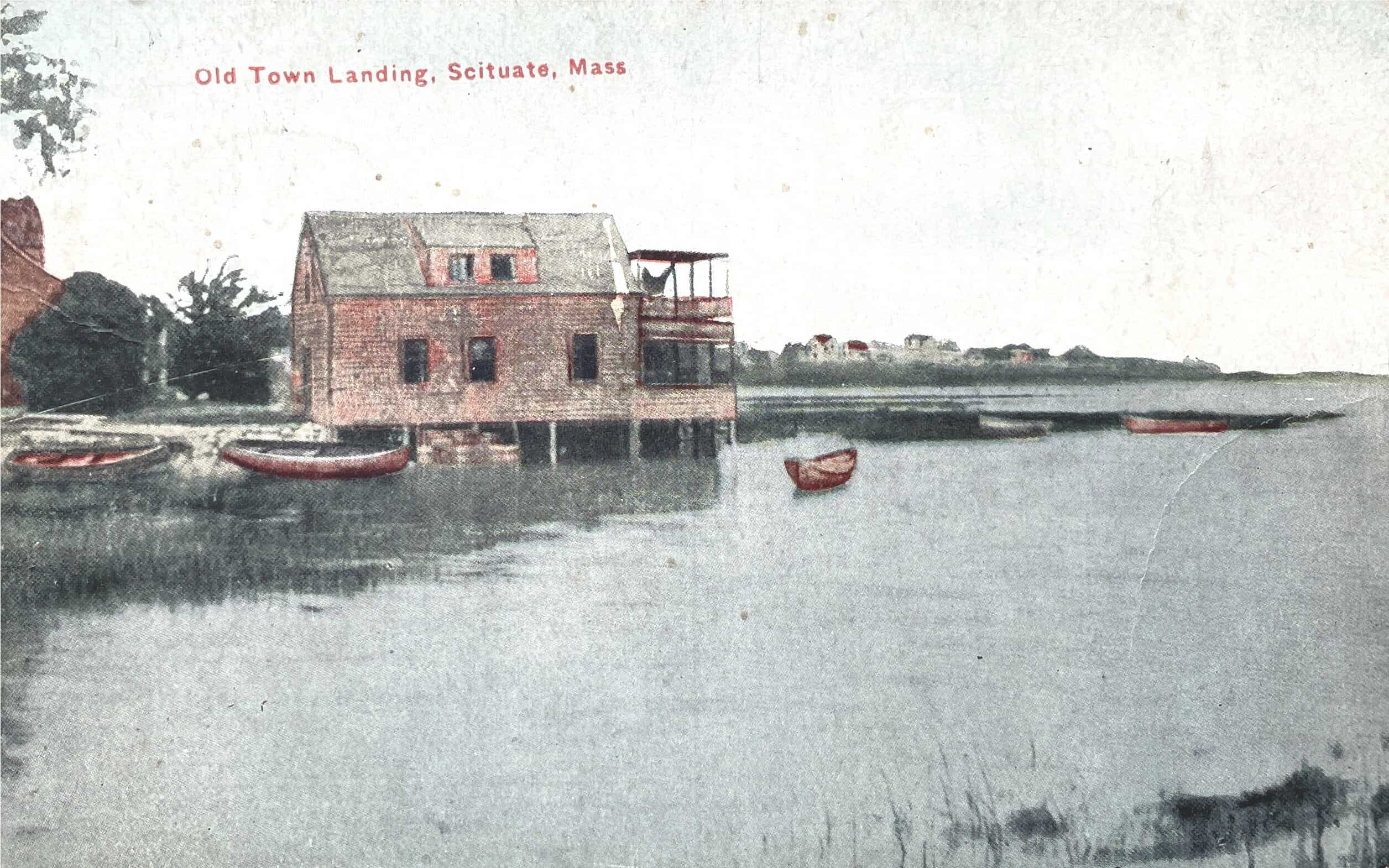
His boats had a reputation on the South Shore and beyond as being the finest sea-going craft because of their beauty, maneuverability, and speed. This was especially true for what became known as the Kingston Lobster boat, although some boating enthusiasts believe that the proper name for them is the Plymouth Lobster Boat, a reference to Plymouth Bay not the Town of Plymouth. These boats were mainly used by lobstermen but in the 1890s and early 1900s they were also used for pleasure and racing. They were 19’ long with a beam just over 6’ and built of narrow ½” pine strips, each edge nailed to the next, making the hull extremely strong. In the 1880s, Capt. Bill was hired by a group of wealthy summer residents known as the “Egypt Syndicates” to go out deep-sea fishing or sailing on one of his very comfortable and roomy sail boats. At the end of one summer season they presented him with a gold watch, which he cherished over his remaining years.¹⁶
During the famous 1898 Portland Gale Capt. Bill’s boat shop was lifted off its posts and toppled, but he continued to make boats in the Harbor until 1908, when at the age of 80 he sold his shop. In 1956, two Scituate residents discovered a Kingston Lobster boat in a field off Country Way and donated it to the Marine Museum in Mystic, Connecticut, where it was restored and can be viewed today.¹⁷
The next renowned Scituate boat builder was Warren Prescott “Scotty” Gannett, who was a descendant of early settlers after whom Gannett Road in North Scituate is named. Born in Scituate in 1875, as a young boy Gannett spent a lot of time in the Harbor observing how Capt. Bill Bates built his boats, becoming an expert boat builder in his own right, building boats in his shop behind his house. Gannett built small boats, such as skiffs, to fairly large sailing vessels. However, he was especially well known for his Friendship Sloops. These boats were 25 to 30 feet long and, like his mentor Capt. Bill Bates’ boats were known for their high level of craftsmanship.
People beyond Scituate and the South Shore who wanted to buy a high quality boat sought Gannett out. He supposedly insisted on meeting any potential customer to decide if he liked the person and would only agree to build them a boat if he liked them. Today Gannett’s boats are hard to come across and are highly prized. However, in 2013, Scituate resident Jack Turner donated a skiff built by Gannett in 1937, and given to him by his father, to the Scituate Historical Society. It can be viewed today at the Society’s Maritime and Irish Mossing Museum.¹⁸
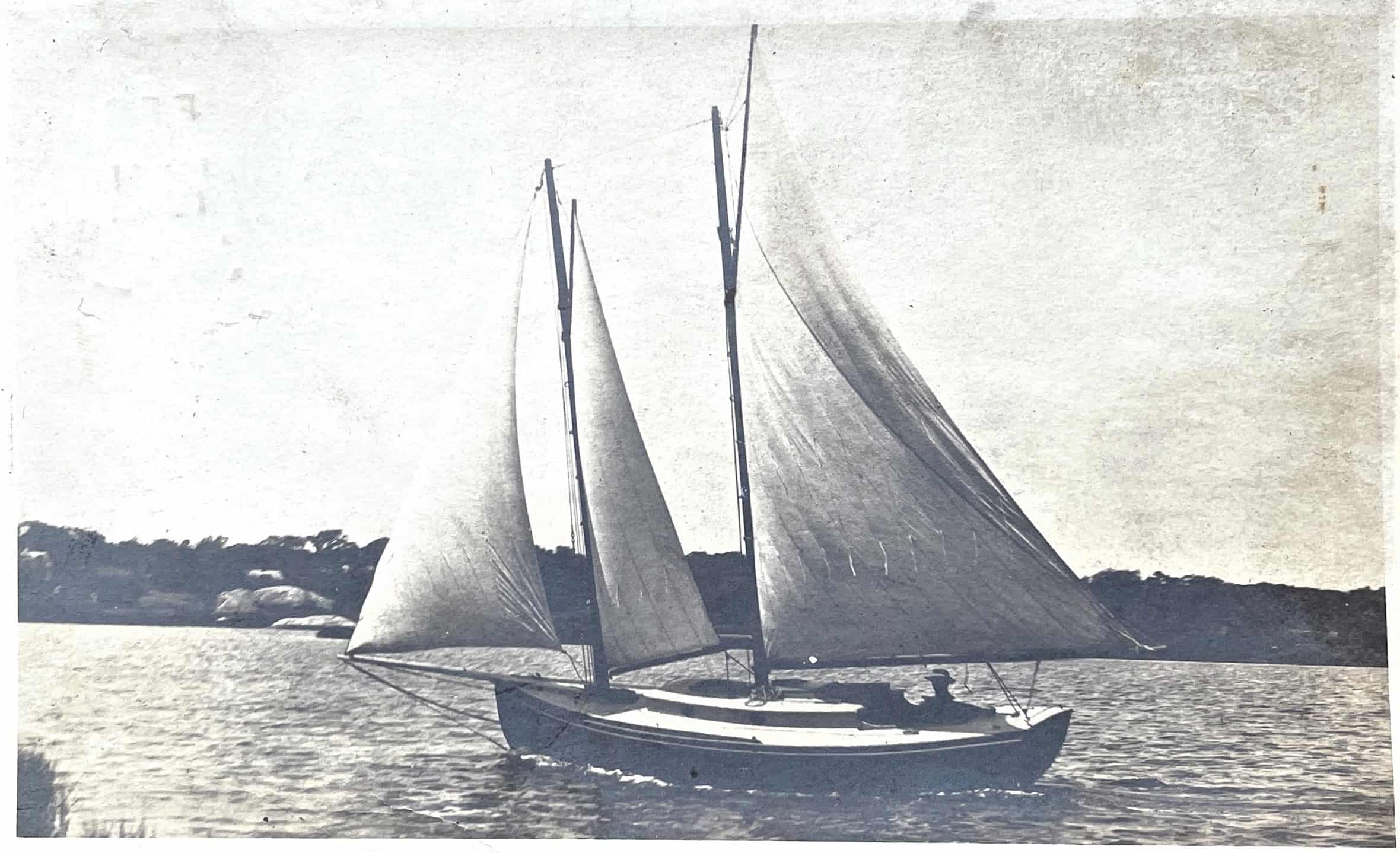
The last of the notable post-Civil War boat builders in Scituate is Charles McGinnis. In 1942, McGinnis, along with two partners, founded the Northeast Shipbuilding Company. From 1943 to 1945 the company built deck barges, tugs, cargo barges and landing craft for the U.S. Army at Cove Bay in Quincy and in Scituate Harbor, where boats were built at the reactivated Will James’s Dock bringing us back full cycle to the earliest days of ship building in the Harbor.¹⁹ In 1946, after the war ended, McGinnis converted to a peacetime operation and built commercial fishing boats for a few years until the expansion of the Welch Company operation took over the James Dock. His most famous boat was the ‘Northeaster’ a 33’ boat built, as a 1946 ad stated, “expressly for lobstermen and tuna fishermen” at a cost of $5,850. In 1947, he built the Northeast Sprint Cruiser, which an ad in Yachting Magazine promoted “as the last word in a sport cruiser….with a frame of white oak and a cabin that sleeps four.”²⁰
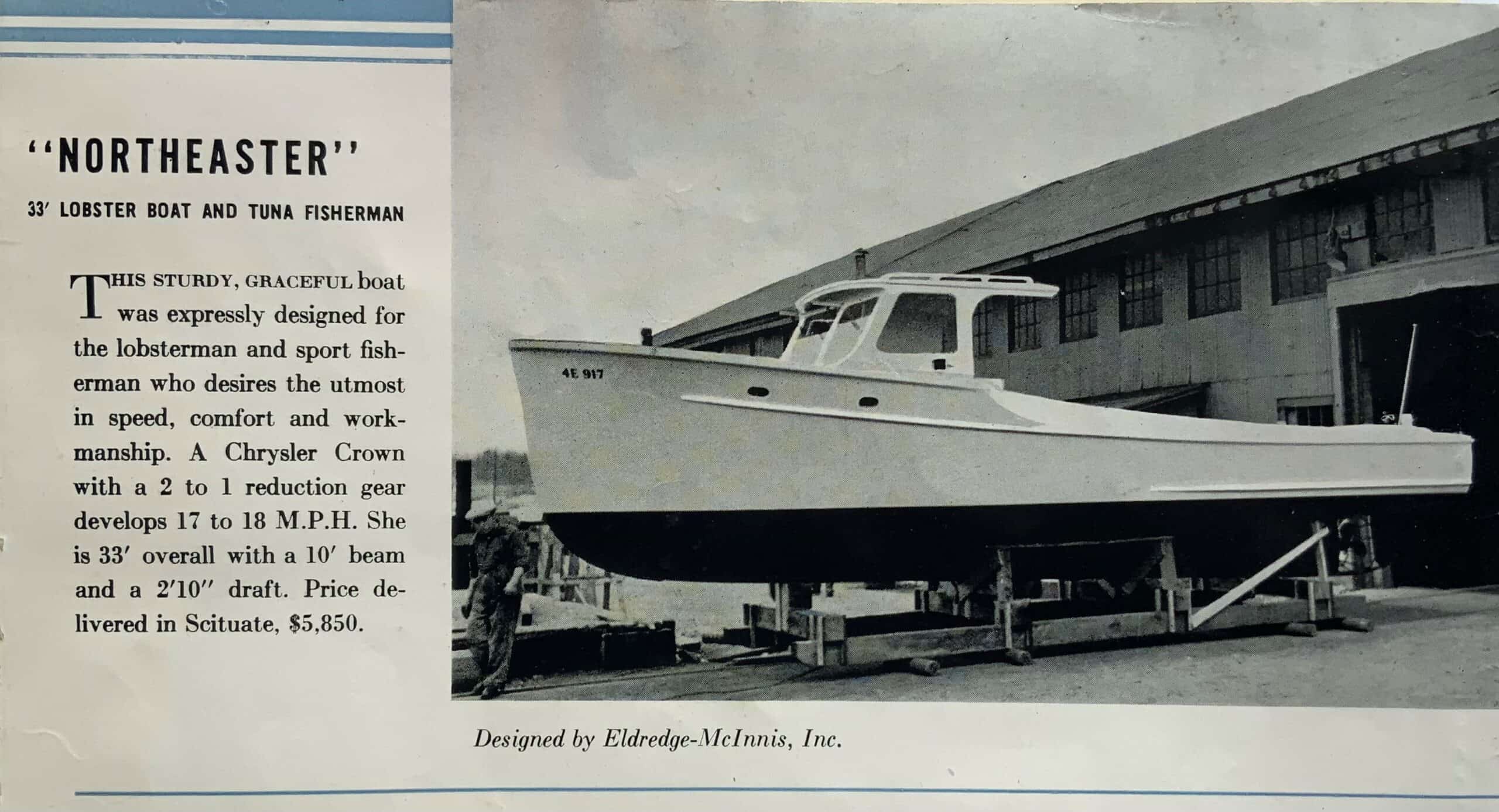
Hopefully, readers of this article will now have a new image of the Harbor. One that includes a bustling, vibrant, maritime harbor where hundreds of ships were built from the 1670s to the 1950s.
Notes
1. Fred Freitas. Coasters & Packers-They’re All Gone Now! Copy of undated article in Shipyard File,
Scituate Town Archives.
2. Samuel Deane. History of Scituate, Massachusetts from Its First Settlement to 1831 (Boston: James Loring,1831). Republished in 1975 by the Scituate Historical Society. 27.
3. L. Vernon Briggs. History of Shipbuilding on North River, 1640-1872 (Boston: Coburn Brothers,1889).
Second reprinting by the Norwell Historical Society, 1981.364. Briggs’ exhaustive study of shipbuilding on the North River and at Scituate Harbor is a must for anyone researching this topic.
4. William Muller. “Shipbuilding in Scituate Harbor and the North River.” Copy of an article written for The Scituate Mariner, March 26, 1975. Shipbuilding File, Scituate Town Archives.
5. Duncan Bates Todd. The Fourteenth Lot. self-published. Scituate, MA. 2005. Chronicle of the history of
the Bates family and their connection to the Harbor. Lots of great stories and photographs.
6. Barbara Murphy, Scituate: The Coming of Age of a Plymouth Colony Town. Self published, Scituate, MA.1985.54. and US Army Corps of Engineers New England District website. “Scituate Harbor Navigation Project.” Information on past and current projects in Scituate Harbor.
7. Harvey H. Pratt. The Harbor at Scituate Massachusetts: Brief on behalf of its improvement as a harbor of refuge and as a commercial port. For the Scituate Harbor Improvement Association, 1913. Includes a summary of the reports of the Board of Engineers for Rivers and Harbors, including their recommendations not to support Scituate Harbor’s designation as a harbor of refuge and to not fund further improvements at the Harbor.
8. Todd, 1,34.
9. Barbara Murphy. Irish Mossers and Scituate Harbor Village. Self published, Scituate,MA, 53-54.
10. Briggs. 337,367.
11. Briggs. 388,390.
12. Briggs. 340,386.
13. Briggs. 380-381.
14. Briggs. 385.
15. Mila Bates Dixon. “Earliest shipbuilding was in Scituate Harbor.” The Scituate Mariner. May 13,1993.
Shipbuilding file, Scituate Historical Society.
16. Todd. 112 and “George R. Law Adds His Bit on ‘Scituate’ Lobster Boats.” South Shore Weekly Mirror, July 19, 1956. 18 & 19. Scituate Town Library Community History Archives. scituate advantage-preservation.com.
17. Todd. 108-113, 119-120.
18. Ruth Thompson. “Rare Scituate-made skiff donated to Historical Society. The Scituate Mariner, WickedLocal.com. January 17, 2013 and Todd.120.
19. Northeast Shipbuilding, Quincy, MA. Spreadsheet of boats built between 1943-1945. http://shipbuildinghistory.com/shipyards/emergencysmall/northeast.htm
20..By the Scituate Historical Society. “The Way We Were-Shipbuildings and Shipyards.” The Scituate Mariner, February 17, 1993, 14. and Northeast Shipbuilding Company catalog February 1, 1946. Shipbuilding File, Scituate Historical Society and Ebay online ads for prints of old boat advertisements.

